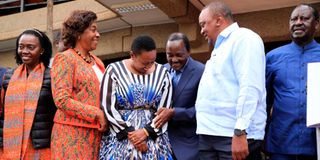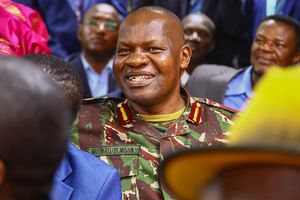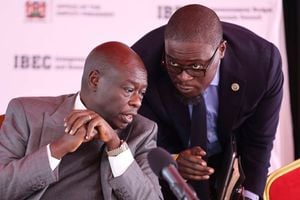What Raila must do to beat Ruto in the Mt Kenya region

Narc-K leader Martha Karua, Kitui Governor Charity Ngilu, Murang’a Woman Representative Sabina Chege, Wiper Party boss Kalonzo Musyoka, and former President Uhuru Kenyatta and Azimio leader Raila Odinga during the inaugural Azimio Council meeting in Nairobi on April 21, 2022.
Nakuru and the Mt Kenya region will be the final political battleground for the two leading candidates for the presidency of Kenya, Mr Raila Amolo Odinga and Mr William Samoei Ruto. Most recent opinion polls show Mr Odinga to be ahead of Mr Ruto in all but the country’s two most populous regions, the Rift Valley and Mt Kenya.
And because Ruto leads Raila in those two regions, he leads Mr Odinga in the race. With the choice of a running mate still pending, Mr Odinga is still in a strong position to overhaul Mr Ruto in Mt Kenya and win the presidency. Why does Mt Kenya matter so much and what are the strategic options for choosing a running mate that are in play? Which candidate has better options?
Gema vote
Mt Kenya accounts for many registered voters, in fact the country’s second-highest after the Rift Valley. A simple miscalculation here would cost either Mr Odinga or Mr Ruto the presidency. If we throw in Nakuru, the region accounts for 5.82 million registered voters. Add to that number the Gema vote in Nairobi, and the region’s vote is over seven million. That means it accounts for more than the combined vote of western Kenya (Kakamega, Vihiga, Bungoma, Busia and Trans-Nzoia), the three Ukambani counties (Kitui, Makueni and Machakos) and the entire Coast region (Mombasa, Kwale, Kilifi, Lamu, Taita-Taveta and Tana River counties), which together account for 6.24 registered million voters.
The problem that Mr Odinga faces is that Mr Ruto has a significant lead over him in the region and even though he has narrowed the gap over the past six months, Mr Ruto’s advantage is sufficient to deny Mr Odinga the presidency. The second problem is that Mr Odinga has only two tools for over-turning Mr Ruto: deploying Mr Kenyatta to mobilise the Kikuyu and his choice of running mate. Mr Ruto, for his part, has the benefit of being ahead in an important region, so doing nothing is still a winning strategy for him. This could be one of the reasons Mr Ruto’s key supporters in Central Kenya – Mr Rigathi Gachagua, Mr Ndidi Nyoro, Mr Kimani Ichung’wa and Ms Alice Wahome have all gone rather quiet.
Losing hand
Unfortunately for Mr Odinga, Mr Kenyatta’s influence in Mt Kenya is waning just when he needs it most. Relying on Mr Kenyatta to assist him overhaul Mr Ruto in the region now looks like a losing hand. But even if it were possible that Mr Kenyatta could help, it is unlikely that he can influence the core Kikuyu counties of Nyeri, Murang’a and Nyandarua, where Raila has always done poorly. In 2017, Mr Odinga – running against Mr Kenyatta – got only 1.79 per cent of the vote in Murang’a; 1.2 per cent of the vote in Nyeri and a paltry 0.8 per cent of the vote in Nyandarua.
Even though there is no Kikuyu candidate in this election, it is not a surprise that in those three counties, Mr Ruto leads Mr Odinga by a significant majority. Fortunately for Mr Odinga, these three counties account for only 1.48 million of the 5.82 million Mt Kenya vote.
In 2017, Mr Odinga got 10.2 per cent of the vote in Meru; six per cent of the vote in Tharak-Nithi; seven per cent of the vote in Kiambu County (Mr Kenyatta’s home county); 10.4 per cent of the vote in Laikipia and 14.7 per cent of the vote in Nakuru.
Significant headway
If there are areas in the region where he can still make significant headway, it is in these counties. In fact, he can write off Murang’a, Nyeri and Nyandarua and still bank enough votes in Mt Kenya to win the presidency. By my reckoning, because he has a very strong following in other regions except the Rift Valley, Mr Odinga need only close the gap to Ruto in Mt Kenya to about five to eight per cent to win the presidency. In short, Mr Odinga’s path to the presidency does not necessarily entail him beating Mr Ruto outright in Mt Kenya.
Can he do it? Mr Odinga’s only real tool for catching up with and even overturning Mr Ruto’s edge in Mount Kenya seems to boil down to his choice of running mate. Mr Ruto’s best strategy is to wait out Mr Odinga. Given that the status quo in Mt Kenya is in his favour, Ruto’s winning strategy is to copy whatever Raila does. Raila’s winning strategy is to disrupt Mr Ruto’s. Between now and August 9, Mr Odinga’s best strategy entails acting first and fast, primarily to flatfoot Mr Ruto.
Let us plug in some names into this analysis and see what the strategic options look like. The three leading contenders for Mr Odinga’s deputy are Mr Stephen Kalonzo Musyoka, Ms Martha Karua and Mr Peter Munya, the Cabinet Secretary for Agriculture. Mr Peter Kenneth was once thought a possible candidate but he does not have the political clout to deliver serious votes to Mr Odinga.
Suppose Mr Odinga picks Mr Musyoka, who is from outside Mt Kenya. On the theory that Mr Ruto would do whatever Raila’s does, Mr Ruto would then pick Mr Musalia Mudavadi, a DP from outside Mt Kenya. That is the best strategy for Mr Ruto for two reasons. First, it costs him nothing in Mt Kenya and by choosing Kalonzo, Raila would not disrupt Ruto’s lead in the region. Second, and perhaps more important, by choosing Mudavadi in response to Mr Odinga’s choice of Kalonzo, Ruto would potentially disrupt the politics of western Kenya, a region where Mr Odinga is in the lead.
From where Ruto sits, Kalonzo as Raila’s deputy is strategic nirvana. It increases his options and keeps him in the lead in Mt Kenya. In game theory, we say that in this case Raila’s strategy is dominated, that is, that it is uniformly worse than some other strategy that he could choose. Kalonzo handicaps Raila in other ways too. By my reckoning, Mr Odinga needs at least 45 per cent or 2.61 million votes in Mt Kenya to win. Even in the unlikely event that Kalonzo could bring 70 per cent of the Ukambani vote to Azimio, that would give Mr Odinga just about one million votes, a number unlikely to offset the loss he would suffer in Mt Kenya. That means Mr Odinga should delete Mr Kalonzo Musyoka’s name from the list of potential DPs, irrespective of how vigorously he protests.
That brings Martha Karua and Peter Munya – both of who are my personal friends – into play. Both have Mt Kenya roots. Both are formidable politicians and both have solid reform credentials; Martha as part of the Second Liberation and Mr Munya as the bane of cartels in Agriculture especially in the coffee and tea sub-sectors – crops that are critical to the Mt Kenya economy.
Female and youth voters
It is said in Martha’s favour that she would have a galvanising effect on the female vote. If true, that would be very helpful to Mr Odinga, who has been trailing Mr Ruto among the female and youth voters in polls. The question is whether there is a ‘gender effect’ of choosing a female DP. When Martha Karua ran for president in 2013, she came a distant sixth with only 43,881 votes. One might retort that she was running against two formidable male candidates, Uhuru Kenyatta and Raila Odinga. But such a retort merely confirms that ethnicity trumps gender in Kenya’s politics.
The same could be said for Ms Charity Ngilu’s candidacy in 1997. Ms Ngilu got 488,600 votes, accounting for 7.9 per cent of the total vote. If there is a gender effect in Kenyan politics, it is not as significant as the ethnic effect. But Martha also brings formidable second-liberation credentials. Can these be cashed out in votes? I have been looking closely at the polls and they show that Raila gets ahead of Ruto with a margin that increases with the age of the voter. I reckon that this margin represents Mr Odinga’s second liberation dividend. Averaging this dividend from three different opinion polls, I estimate this to be worth anything from one million to 1.2 million votes. How much larger can Martha’s second liberation credentials add to this number? Hard to say, but it is unlikely to be larger than Mr Odinga’s.
Of immediate strategic concern to Mr Odinga is the fact that the second liberation dividend is a national vote, not a Mt Kenya vote. Which is what Mr Odinga needs. There is another down-side: Martha does not come with a large number of home votes. Kirinyaga accounts for only 378,580 votes and it has not been a Raila county. In 2017, Mr Odinga got 1.03 per cent of the vote here, his second worst performance in Mt Kenya.
But what would Ruto do if Raila chose Martha? The smart thing would be to choose a woman candidate, say Ms Anne Waiguru, the Governor of Kirinyaga. Ms Waiguru would nullify any gender effect that Martha brings whilst also disrupting her impact in Kirinyaga.
What does Mr Peter Munya’s candidacy look like? Mr Munya has many of the formidable characteristics that Martha Karua brings. One key difference between them is electoral math: with Munya as DP, the overwhelming majority of the over one million Meru and Tharaka-Nithi votes would go to Azimio, likely wiping out UDA in the larger Meru region. Moreover, Meru has always had a core Odinga base of roughly 10 per cent of the vote. The three counties in which Raila must do well to beat Ruto in Mt Kenya are Meru with 1.02 million votes, Kiambu with 1.29 million votes and Nakuru with 1.05 million votes. Of the three, only Meru can potentially be fully turned to Azimio. Kiambu and Nakuru counties will split no matter who Mr Odinga chooses for running mate and all three will split, to the relief and benefit of Mr Ruto if Mr. Odinga does not have a Meru running mate.
The most intriguing part of a Munya nomination is that it would disrupt Ruto in a high population region – Meru and Tharaka-Nithi – and deny him a true opportunity to copy Raila’s strategy. Ruto’s problem in Meru is that the two giants of Meru politics, Munya and Kiraitu, are in Azimio and the leading UDA person in Meru is Mr Kindiki Kithure, a politician with nowhere near the star power of the other two. So Ruto would probably end up seeking a Mt Kenya candidate from among the Kikuyu, which would help solidify the Meru vote further. But can Munya help sell Raila in the rest of Mt Kenya?
Probably. The reforms Mr Munya has implemented in the coffee, tea, pyrethrum and dairy subsectors have put money in the pockets of many small-holder farmers. These reforms carry substantial political capital but that needs to be cashed in lest it dissipates.
This analysis leaves both candidates in a quandary: If Mr Ruto acts first to pick a running mate, he would give Raila more strategic flexibility. If Raila acts first, Ruto would potentially stay ahead by merely mimicking whatever Mr Odinga does.
But Mr Odinga’s only strategically dominant option is to act first and disrupt Mr Ruto in one or more of the high population counties of Mt Kenya. It is a delicious conundrum. Enjoy.
Wachira Maina is a constitutional lawyer and governance specialist.





